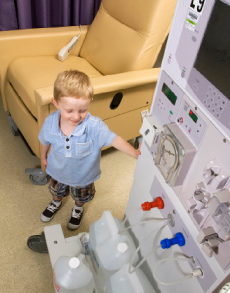Research: Questions and answers that matter
As Emory researchers define the school’s research goals and strategy for the next five years, their focus is less on “market share” (number and value of research awards compared with those of other schools) and more on “mind share”—how they are using the awards and how their work will matter in the long run.
How, for example, will their efforts help people with cancer, autism, or Alzheimer’s? How will their work contribute to what other scientists across the world are doing to help fight such diseases as well?
It isn’t that these researchers can’t take considerable pride in their market share—it’s just that they understand their real goal, which is to leave a lasting impact on science and on society.*
Following are examples of how these researchers are looking for answers that will truly matter to patients in the long run.
|
In this section |
Protecting brain cells
Several years ago, an Emory researcher discovered that progesterone plays a neuroprotective role following traumatic brain injury. A new Emory-directed phase 3 trial of progesterone began this year in 17 trauma centers nationwide. Progesterone eventually may prove effective in mitigating other types of brain damage as well.
Emory researchers now also have identified other substances that may protect brain cells from the toxicity associated with seizure, stroke, Parkinson’s, and other neurologic diseases. One such compound mimics BDNF, a brain-derived growth factor that is unable to cross the blood-brain barrier when administered as a drug. The new BDNF-like compound, a flavonoid found in foods like cherries, overcomes this problem.
Getting the big picture—A new research MRI/PET scanner installed at Emory—one of only four in the world and two in the country—simultaneously collects PET and MRI images so that the neural state of the patient is the same during both acquisitions. It also shortens the time of collection for research subjects who are cognitively impaired and/or have trouble tolerating scanning procedures.
Effective treatment for dystonias—Current treatments for the muscle contractions and spasms of dystonias are generally ineffective, and Emory is leading an 18-center Dystonia Coalition, funded by a five-year, $6 million NIH grant, to develop effective treatment for the most common of these disorders, which appear to share genetic and environmental risk factors.
Improving ACE inhibitors—ACE inhibitors were a major advance in treating hypertension, but they sometimes stop working after several months (“ACE inhibitor escape”), and they never work well for some groups, including African Americans. Emory scientists and colleagues at University of Alabama and Fukuoka University in Japan discovered why and what to do about it. ACE inhibitors work by preventing the body from processing angiotensin II, a hormone that constricts blood vessels, thus elevating blood pressure. The scientists found that another enzyme, chymase, also can process angiotensin. Adding drugs that interfere with chymase to ACE inhibitors significantly boosted recovery of heart function in animals after heart attack. This paves the way for studies in humans.
Getting SOD to the rescue—Enzymes were key to a discovery by Emory and Georgia Tech researchers: a way to get extra amounts of an antioxidant protein to the cells that need it following heart attack. When injected, the enzyme superoxide dismutase (SOD) remains in the body too briefly to have beneficial effects. Microscopic polymer beads developed by the Emory/Tech team, however, proved effective in rats in delivering SOD to heart cells after simulated heart attack, reducing cell death and improving cardiac function.
Biomarkers of oxidative stress—In a study of more than 1,200 people undergoing cardiac imaging because of suspected heart disease, people with high blood levels of cystine were twice as likely to have a heart attack or die over the next few years. The finding was independent of variables such as diabetes and levels of C-reactive protein. Cystine could be a valuable marker of cardiovascular risk, and it also may point to a helpful new treatment strategy. Previous studies have found that oxidized cystine blood levels tend to rise with aging and with tobacco and alcohol consumption, and that they can be lowered with zinc supplementation.
Bacterial factors—Emory pathologists reported new evidence that bacteria contribute to obesity and metabolic disease. Mice engineered to lack the TLR5 gene, which helps control bacteria in the intestine, ate more, weighed more, and exhibited metabolic syndrome. Transfer of intestinal bacteria found in the TLR5-deficient mice to regular mice transferred many of the characteristics of metabolic syndrome, including increased appetite, obesity, elevated blood sugar, and insulin resistance.
Behavioral factors—Neuroscientists at Yerkes National Primate Research Center found that subordinate monkeys generally ate less and weighed less than dominant monkeys—until their low-fat diet was changed to one high in fat and sugar. Then the subordinate monkeys ate almost nonstop and continued to do so when the diet went back to low fat, suggesting that their set point had changed and that they had learned that food, any food, could alleviate the chronic stress caused by their low social status.
Developmental disorders
Fragile X syndrome—Emory geneticist Stephen Warren discovered the mutated gene that causes fragile X syndrome, the most commonly inherited cause of intellectual disability, and he later developed the first screening test. Now a compound developed by Warren is in phase 2 clinical testing at Emory and four other centers. If effective, it would be the first pharmaceutical treatment for fragile X and could open the door for treatment of other autism spectrum disorders.
Autism—Thanks to a $3.4 million federal stimulus award to Emory, raw genetic data from more than 200,000 cases of autism collected from 100+ clinical labs around the world soon will be available online. The new International Standard Cytogenomic Array Consortium follows the model of the Human Genome Project, in which all data are freely and publicly available.
Strategies in cancer
MRI for detection—Emory researchers in surgery, radiology, and biomedical engineering have developed tools to improve breast cancer diagnosis by attaching iron oxide nanoparticles to a molecule that binds specifically to breast cancer cells. In mice with implanted human tumors, injected nanoparticles stay in the blood for several hours, during which time they are taken up by breast cancer cells, where they are clearly visible under MRI. Researchers believe this is an important step toward developing cancer-specific breast MRI that could allow for early detection and treatment monitoring. Women with inherited and other cancer risk factors could especially benefit.
Viral links to prostate cancer—Emory researchers have developed a clinical test for a retrovirus recently found in some patients with prostate cancer. Little is known about transmission of xenotropic murine leukemia-related virus (XMRV), and no method is available to screen blood or tissue donors for possible infection. The Emory technology, adapted from HIV antibody assays, will make it possible not only to test for infection but also to answer basic questions about XMRV transmission, frequency, and association with prostate cancer. In a separate study at Emory and University of Utah, researchers found that four drugs currently approved for treating HIV can inhibit XMRV.
Preventing angiogenesis—When cancer cells outgrow their blood supply, they send out signals to encourage new blood vessel growth. Winship Cancer Institute researchers recently identified a chemical that puts a monkey wrench into the cells’ machinery for responding to low-oxygen conditions. The compound KC752 stops cells from making HIF-1a to essentially suffocate the cancer cells. The researchers believe the identification and development of novel HIF-1 pathway inhibitors may lead to new types of treatment for many solid tumors.
Leveraging cancer data—Emory’s Center for Comprehensive Informatics was awarded grant funds from the National Cancer Institute based on its standing as one of five “In Silico” Research Centers of Excellence. The goal of the program is to empower research in which rich data sets currently available to the cancer community are analyzed to produce discoveries leading to more effective treatments. Emory’s center will leverage vast amounts of molecular, pathology, and radiology data on brain tumors
Building for children—Emory has a longstanding partnership with Children’s Healthcare of Atlanta, with groundbreaking scheduled soon for a joint research building. The building will house research in heart, cancer, vaccines, and new drug discoveries. Children’s also is investing $75 million to establish eight research centers in cancer, immunology and vaccines, transplant immunology and immune therapeutics, technology innovation, cystic fibrosis, developmental lung biology, endothelial cell biology, and cardiovascular biology.
Individualizing Crohn’s treatment—Emory recently received a $5 million grant from the Crohn’s and Colitis Foundation to study Crohn’s disease in children. The multi-center study will enroll 1,000 children with newly diagnosed disease from 20 pediatric centers across the nation, with the goal of finding biomarkers of risk for complications that may require surgery, thus allowing individualized therapy.
Predicting vaccine effectiveness—Scientists at Emory Vaccine Center recently received a $15.5 million NIH grant to use “systems” vaccinology to predict vaccine-induced immunity. Combining tools in immunology, genomics, and bioinformatics, this approach permits them to observe a global picture of the nearly 30,000 genes, proteins, and cells participating in immune responses to vaccination. With yellow fever vaccine (one of the most successful vaccines ever developed), the investigators identified signatures of gene expression in the blood a few days after vaccination that could predict the strength of the immune response with up to 90% accuracy. They also will use combined tools to predict effectiveness of vaccines for flu, pneumonia, and shingles, which currently are ineffective in a substantial proportion of the elderly.
International conferences—Emory and University of Georgia hosted an international symposium on H1N1 last spring, and this fall Emory’s Center for AIDS Research will serve as local host of AIDS Vaccine 2010, the largest global scientific conference on this topic.
 |
Little kids vs. big machinesEmory physicians teamed up with both Children’s Healthcare of Atlanta and Georgia Tech to develop a kidney replacement device for children needing dialysis. (The one at left is for adults.) There are no FDA-approved devices specifically designed for children, and adult devices adapted for children can be inaccurate and potentially dangerous. The device being developed can be used for patients weighing as little as 6 pounds. |
|||
*Emory medical faculty received more than $420 million in sponsored research last year, including awards received via Yerkes National Primate Research Center, Atlanta VA Medical Center, Winship Cancer Institute, and Emory’s Center for Comprehensive Informatics.

